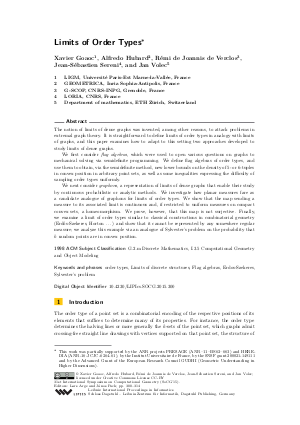Limits of Order Types
Authors Xavier Goaoc, Alfredo Hubard, Rémi de Joannis de Verclos, Jean-Sébastien Sereni, Jan Volec
-
Part of:
Volume:
31st International Symposium on Computational Geometry (SoCG 2015)
Part of: Series: Leibniz International Proceedings in Informatics (LIPIcs)
Part of: Conference: Symposium on Computational Geometry (SoCG) - License:
 Creative Commons Attribution 3.0 Unported license
Creative Commons Attribution 3.0 Unported license
- Publication Date: 2015-06-12
File

PDF
LIPIcs.SOCG.2015.300.pdf
- Filesize: 0.63 MB
- 15 pages
Document Identifiers
Subject Classification
Keywords
- order types
- Limits of discrete structures
- Flag algebras
- Erdos-Szekeres
- Sylvester’s problem
Metrics
- Access Statistics
-
Total Accesses (updated on a weekly basis)
0Document
0Metadata
Abstract
The notion of limits of dense graphs was invented, among other reasons, to attack problems in extremal graph theory. It is straightforward to define limits of order types in analogy with limits of graphs, and this paper examines how to adapt to this setting two approaches developed to study limits of dense graphs. We first consider flag algebras, which were used to open various questions on graphs to mechanical solving via semidefinite programming. We define flag algebras of order types, and use them to obtain, via the semidefinite method, new lower bounds on the density of 5- or 6-tuples in convex position in arbitrary point sets, as well as some inequalities expressing the difficulty of sampling order types uniformly. We next consider graphons, a representation of limits of dense graphs that enable their study by continuous probabilistic or analytic methods. We investigate how planar measures fare as a candidate analogue of graphons for limits of order types. We show that the map sending a measure to its associated limit is continuous and, if restricted to uniform measures on compact convex sets, a homeomorphism. We prove, however, that this map is not surjective. Finally, we examine a limit of order types similar to classical constructions in combinatorial geometry (Erdos-Szekeres, Horton...) and show that it cannot be represented by any somewhere regular measure; we analyze this example via an analogue of Sylvester's problem on the probability that k random points are in convex position.
Cite As Get BibTex
Xavier Goaoc, Alfredo Hubard, Rémi de Joannis de Verclos, Jean-Sébastien Sereni, and Jan Volec. Limits of Order Types. In 31st International Symposium on Computational Geometry (SoCG 2015). Leibniz International Proceedings in Informatics (LIPIcs), Volume 34, pp. 300-314, Schloss Dagstuhl – Leibniz-Zentrum für Informatik (2015)
https://doi.org/10.4230/LIPIcs.SOCG.2015.300
BibTex
@InProceedings{goaoc_et_al:LIPIcs.SOCG.2015.300,
author = {Goaoc, Xavier and Hubard, Alfredo and de Joannis de Verclos, R\'{e}mi and Sereni, Jean-S\'{e}bastien and Volec, Jan},
title = {{Limits of Order Types}},
booktitle = {31st International Symposium on Computational Geometry (SoCG 2015)},
pages = {300--314},
series = {Leibniz International Proceedings in Informatics (LIPIcs)},
ISBN = {978-3-939897-83-5},
ISSN = {1868-8969},
year = {2015},
volume = {34},
editor = {Arge, Lars and Pach, J\'{a}nos},
publisher = {Schloss Dagstuhl -- Leibniz-Zentrum f{\"u}r Informatik},
address = {Dagstuhl, Germany},
URL = {https://drops.dagstuhl.de/entities/document/10.4230/LIPIcs.SOCG.2015.300},
URN = {urn:nbn:de:0030-drops-51264},
doi = {10.4230/LIPIcs.SOCG.2015.300},
annote = {Keywords: order types, Limits of discrete structures, Flag algebras, Erdos-Szekeres, Sylvester’s problem}
}
Author Details
References
-
B. Abrego, S. Fernandez-Merchant, and G. Salazar. The rectilinear crossing number of k_n: Closing in (or are we?). In Thirty Essays on Geometric Graph Theory, pages 5-18. Springer, 2013.

-
O. Aichholzer, F. Aurenhammer, and H. Krasser. Enumerating Order Types for Small Point Sets with Applications. In Proc. 17^th Ann. ACM Symp. Computational Geometry, pages 11-18, Medford, Massachusetts, USA, 2001.

-
N. Alon. The number of polytopes, configurations and real matroids. Mathematika, 33:62- 71, 1986.

-
G. Aloupis, J. Iacono, S. Langerman, Ö. Özkan, and S. Wuhrer. The complexity of order type isomorphism. In Proceedings of the Twenty-Fifth Annual ACM-SIAM Symposium on Discrete Algorithms, SODA'14, pages 405-415, 2014.

-
B. Borchers. CSDP, A C library for semidefinite programming. Optimization Methods and Software, 11(1-4):613-623, 1999.

-
P. Brass, W. Moser, and J. Pach. Research Problems in Discrete Geometry. Springer, 2005.

-
P. Erdős and G. Szekeres. On some extremum problems in elementary geometry. Eotvos Sect. Math, 3-4:53-62, 1962.

-
J. D. Horton. Sets with no empty convex 7-gons. Canad. Math. Bull., 26:482-484, 1983.

-
L. Lovász and B. Szegedy. Limits of dense graph sequences. J. Combin. Theory Ser. B, 96(6):933-957, 2006.

- E. Lubetzky and Y. Zhao. On replica symmetry of large deviations in random graphs. Random Structures & Algorithms, 2014. URL: http://dx.doi.org/10.1002/rsa.20536.
-
A. A. Razborov. Flag algebras. J. Symbolic Logic, 72(4):1239-1282, 2007.

-
E. Scheinerman and H. Wilf. The rectilinear crossing number of a complete graph and sylvester’s "four point problem" of geometric probability. Amer. Math. Monthly, 101:939-943, 1994.

-
P. W. Shor. Stretchability of pseudolines is NP-hard. In Applied Geometry and Discrete Mathematics: The Victor Klee Festschrift, volume 4 of DIMACS Series in Discrete Mathematics and Theoretical Computer Science, pages 531-554. Amer. Math. Soc., 1991.

- W. A. Stein et al. Sage Mathematics Software (Version 6.1). The Sage Development Team, 2013. URL: http://www.sagemath.org.
